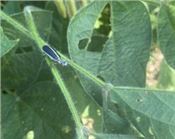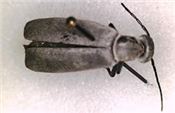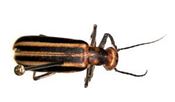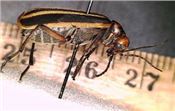Blister Beetles Predatory Behavior Outweigh Their Feeding In Soybeans In Kentucky
DR.RAUL T. VILLANUEVA
PRINCETON, KEN.
Blister beetles (Coleoptera: Meloidae) are known for the oily, caustic substance that protects them from predators: cantharidin. Cantharidin is a defensive substance that acts as a deterrent against ants or ground beetles and several species of spiders. In pastures, cantharidin can severely injure livestock. If beetles are trapped in the hay and ingested with the hay, especially by horses, this substance can irritate the gastrointestinal and urinary tracts of these animals, and lead to poisoning, even death. Blister beetles cause irritations or blisters on human skin; this happens when the beetle is pressed or rubbed against the skin.
Adult blister beetles have narrow bodies, and their length can be between 3/4 and 1 1/4 inch. Their head is broad compared with their thorax. The front wings are soft and flexible in contrast to the hard front wings of most beetle species. The antennae are approximately 1/3 the length of their entire body.
Blister beetles in soybeans
Blister beetles can be observed in soybean fields from June to August.
Adult beetles feed in soybean foliage (Figure 1) but do not cause economic damage. However, the larval stages are predacious and beneficial insects. Female blister beetles lay egg masses in the soil near grasshopper eggs. Once blister beetle larvae hatch, they start to feed aggressively on the eggs of grasshoppers. There are studies that show larvae can play an important role in reducing grasshopper populations in some areas, although they may be unpredictable from one year to the next.
Adult blister beetles have been observed affecting edges of vegetables, potatoes, and on ornamental plants; however the damage is minimal and most plants can tolerate it. Chemical control is not recommended, and in soybeans, there are no thresholds to control these beetles.
Species
There are more than 31 species of blister beetles; species are found in South and North America.
Several species of blister beetles can be found in soybeans in Kentucky, and they include the margined (Epicauta funebris) (Figure 1), ashgray (Epicauta fabricii) (Figure 2), striped (E. vittata) (Figures 3 and 4), and black (E. pennsylvanica). ∆
DR. RAUL T. VILLANUEVA: Entomology Extension Specialist, University of Kentucky

Figure 1. Adult margined blister beetle, Epicauta funebris and feeding on soybeans.
Photos: Raul Villanueva, UK

Figure 2. Adult ashgray blister beetle, Epicauta fabricii.

Figure 3. Adult striped blister beetle, Epicauta vittata.

Figure 4. Lateral view of an adult striped blister beetle, Epicauta vittata.